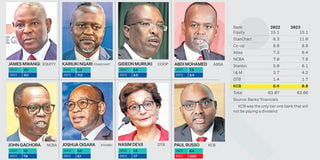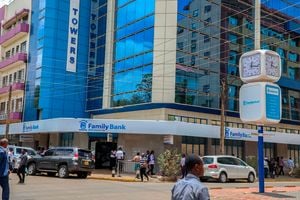
Tier one banks’ cumulative dividends remained flat in the year ended December 2023, as lenders made huge provisions to shield themselves from Sh133 billion defaults.
The large banks have proposed to pay their shareholders Sh63.06 billion for the period, effectively unchanged from the Sh63.07 billion they distributed in the year ended December 2022.
Their collective net profits rose by 6.6 percent or Sh11.43 billion in 2023 to Sh185.9 billion, defying a general decline in banking sector earnings in the period on the back of elevated non-performing loans.
Banks operated in a difficult environment last year, resulting in an increase in non-performing loans for the sector from Sh133.6 billion to Sh621.3 billion between January and December 2023.
The uncertain conditions resulted in mixed dividend policies for the top lenders, with some opting for a conservative approach to protect or boost capital.
KCB, which reported an 8.3 percent drop in net profit to Sh37.46 billion in 2023, opted not to pay a dividend for the first time in 21 years in order to preserve capital.
Co-operative Bank of Kenya and Equity Group held their payouts constant at Sh1.5 and Sh4 per share respectively, even as the latter reported a 6.48 percent fall in net earnings to Sh41.98 billion.
“Our liquidity is at 54 percent, with Sh300 billion in cash or near cash, and are only paying Sh15.1 billion. Cash flow is not a problem and risk has already been mitigated by increased provision in the year,” said Equity Group chief executive James Mwangi on Wednesday.
Standard Chartered Bank Kenya is proposing to distribute Sh10.96 billion (2022: Sh8.3 billion) after raising its dividend per share to Sh29 from Sh22 in 2022. Equity’s payout remains the highest in the sector ahead of StanChart, with Co-op Bank third at Sh8.8 billion. Multinational lenders StanChart, Stanbic Holdings, and Absa Bank Kenya recorded the highest growth in absolute payouts on the back of record profits.
Absa and Stanbic have both proposed to raise their total payout by Sh1.09 billion each, to Sh8.42 billion and Sh6.07 billion respectively. Absa raised its dividend per share by Sh0.20 to Sh1.55 per share, while Stanbic’s rose to Sh15.35 per share from Sh12.60 in 2022.
DTB is raising its distribution by 20 percent or Sh279.6 million to Sh1.68 billion, NCBA by 12 percent or Sh823.8 million to Sh7.83 billion, and I&M Group by 13 percent or Sh496 million to Sh4.22 billion.
NCBA managing director John Gachora said that the stronger return to shareholders reflected momentum in all the bank’s financial drivers, even as the bank keeps an eye on protecting its capital adequacy ratios.
“We also have capital adequacy ratios that we hope to maintain to support our business. We also make investments to maintain our board-mandated capital ratios,” he said at the lender’s financial briefing on Wednesday.
The bank posted a 55.7 percent growth in net profit to Sh21.4 billion in 2023.
Dividends have become a key investment consideration for investors when buying shares at the Nairobi Securities Exchange (NSE) in recent years due to limited capital gains on most stocks.
Lower share prices also boost the dividend yields of companies, making their returns competitive against competing asset classes such as bonds and fixed deposits.
Large banks, alongside a few other blue chip companies like Safaricom, East African Breweries Plc (EABL) and BAT Kenya have been the most consistent distributors of profits to shareholders, which has helped them maintain investor appetite for their stocks.
Bank shares have over the past month recorded gains of between 11.6 percent (Absa) and 53.6 percent (KCB), largely on expectations of higher dividends. The rally started after StanChart and Stanbic announced their record dividends, with investors taking a position early on the other bank stocks to avoid having to pay a premium if prices rose on high dividend payouts.
Although subsequent dividend announcements by other banks presented a mixed bag, the demand for the shares remained strong among local investors, driving the stocks to multi-month highs.









